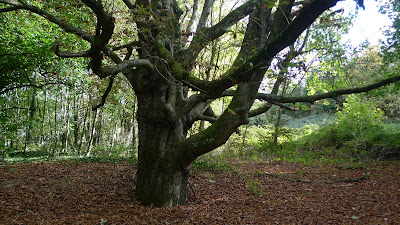
November and December seem to always zip by so quickly, it's like the last burst of speed to the finish line, and then poof! There goes 2010. But we still have some time...and in that time, I've been to Brittany and Normandy (as well as Turin, Italy, but I'll save that for later). It was cool and breezy, with picturesque greys and greens. Everything was still lush from the rain, the oysters were out of control delicious and briny, the cows producing spectacularly silky dairy products for the richness that is the Breton and Norman cuisine, figs were oozing sweetness out of their purplish brown skins begging for a pungent aged camembert, and the walnut and chestnut tree's were half way through dropping their fruit for us to enjoy. I stocked up on sea salt in all it's shapes and forms along the way, and lugged it back in a borderline too heavy suitcase with an exasperated husband.
This trip was particularly tasty and it was hard to narrow it down, so I've focused on the seasonal and medicinal delights that we encountered along the way.

The first treat we got to nibble away at were tender, sweet, purple figs. Figs travelled a long way to get to France, as they were likely first cultivated 6,000 years ago in Asia Minor before reaching the Mediterranean. There are two seasons for figs in France, late summer and mid Fall to around November. From the perspective of Chinese Medicine, purple figs are excellent blood and digestive tonics given that they are sweet and reddish in color. In addition, their multitudinous miniature seeds which you ingest upon taking a bite of this fruit, are extremely effective in the treatment of constipation. In Chinese Medicine theory, seeds and nuts are used to help lubricate and move the bowels. Sexy stuff! For those that squirm when I mention your digestive regularity, fear not, figs are well worth it when in season, regardless of your intentions.

(oysters vendors by the piers in Cancale)

Cancale, France is possibly one of my favorite places on earth. Allow your eyes to glaze over and see past the touristy bits of this quaint seaside fishing village, they have some of the BEST oysters I have happily slurped down in my life. That's saying a lot given that I would eat oysters for breakfast, lunch, and dinner in my dream life. They tasted like a trip across the ocean with the salty water and sun splashing on your face. Much like when you put a big shell to your ear to hear the roar of the ocean, these oysters tasted pure like that sound. And in Chinese Medicine they fall into the category of kidney tonics given their salty taste and briny beginnings. In France, oysters are being gobbled up in the November and December months and they are a common staple at the Christmas table. In popular (and ancient) culture, oysters have always been given aphrodisiac status, which falls in line with the kidney tonic theory that Chinese Medicine lends them as the kidneys are key in matters of fertility.

(walnut tree)

(fallen walnut)

(chestnut tree)

(saved chesnut)
Oysters aren't the only kidney tonics, walnuts and chestnuts also fall in line with this medicinal value. We were lucky enough to have access to a walnut tree in a family members back yard and a chestnut tree at a manor where we attended a wedding. Walnuts are particularly beneficial to the kidney yang aspect of the body, meaning : chronic cough with wheezing, infertility, chronic lower back pain and weakness, and impotence. Walnuts are thermally warming, have a sweet flavor, and reduce inflammation as well as eliminate pain (Healing With Whole Foods, P. Pitchford). Chesnuts, another lovely winter nut found in abundance during this time of year treat the kidney, stomach, and spleen, giving them the additional benefit of being digestive tonics on top of their kidney benefits.

Ahhh, the lovely cows everywhere we drove through Brittany and Normandy! They were all standing about chewing away peacefully until I would force whoever was driving to stop so I could take the millionth picture of another cow and it would inevitably turn around and face me, stop chewing, and wonder why I had to disturb it (much like in the picture above). Bovine dairy is a bit controversial at times, due mainly to poor breeding and production practices, but it also has it's place medicinally when you can access healthy dairy like the dairy found in Brittany and Normandy where the cows are out to pasture and aren't fed bovine growth hormone or antibiotics (primarily because they are out to pasture and there is no rush). From the perspective of Chinese Medicine, milk has building and strengthening properties so long as you are not suffering from any of the following (in which case, use in moderation or not at all): sinus congestion, chronic skin issues, obesity, or phlegm. If you want to know more about milk, see here for a previous post on it. In Brittany and Normandy, it was hard to resist the excellent butter, delicious milk, and not to mention the phenomenal cheeses (Camembert, Pays d' Auge, and the variety of chevres) everywhere we went. Many meals ended with a slice of fragrant cheese and prepared our stomachs for the onslaught of Thanksgiving feasting that was around the corner!

(whatcha lookin' at?)
2 comments:
Thanks for the photos and the rhapsodic description of the food, especially the oysters! And the reminders of TCM and food.
Just want to says that the "chestnut" pictured in your hand is *not* a sweet chestnut (Castanea sativa) but a horse chestnut (Aesculus hippocastanum). (Horse chesnut are not eaten raw and traditionnally used against blood circulation/hemorroid problems)
Post a Comment